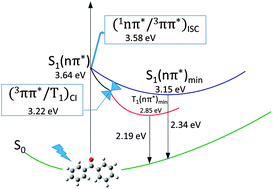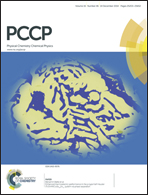Computational determination of the dominant triplet population mechanism in photoexcited benzophenone†
Abstract
In benzophenone, intersystem crossing occurs efficiently between the S1(nπ*) state and the T1 state of dominant nπ* character, leading to excited triplet states after photoexcitation. The transition mechanism between S1(nπ*) and T1 is still a matter of debate, despite several experimental studies. Quantum mechanical calculations have been performed in order to assess the relative efficiencies of previously proposed mechanisms, in particular, the direct S1 → T1 and indirect S1 → T2(ππ*) → T1 ones. Multiconfigurational wave function based methods are used to discuss the nature of the relevant states and also to determine minimum energy paths and conical intersections. It is found that the T1 state has a mixed nπ*/ππ* character and that the T2(ππ*) state acts as an intermediate state between the S1 and T1 states. This result is in line with recent experiments, which suggested a two-step kinetic model to populate the phosphorescent state after photoexcitation [Aloïse et al., J. Phys. Chem. A, 2008, 112, 224–231].


 Please wait while we load your content...
Please wait while we load your content...